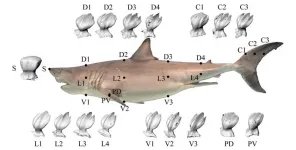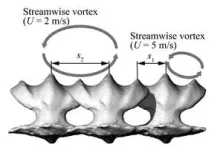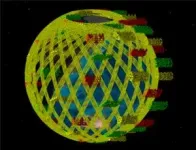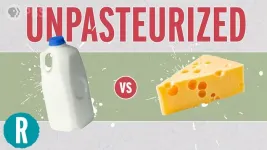(Press-News.org)
New findings on how sharks achieve drag reduction could inspire the design of riblets for more efficient aircraft and boats. In their investigation of great white shark denticles, researchers from Tokyo Tech found that ridge height and spacing play crucial roles in drag reduction at different swimming speeds. Higher middle ridges aid sharks in efficient cruising at slower speeds, while the lower side ridges become more critical for drag reduction during high-speed hunting bursts. The analysis also suggests that the speeds of an extinct giant shark, megalodon, may not much differ from those of the white shark.
The great white shark, one of the ocean's most efficient predators, possesses tiny tooth-like structures on its skin called dermal denticles, which perhaps reduce frictional drag as it moves through the water. The drag reduction would help them to be swift hunters, reaching hunting speeds of up to 6.7 m/s, as well as long-distance swimmers, traveling distances of up to 20,000 kilometers efficiently. Engineers have drawn inspiration from these denticles to design riblets or small unidirectional ridges for aircraft and sailboats. However, the denticles across a shark's body vary in shape, size, and spacing, complicating the understanding of how they collectively affect drag reduction.
In a study published in the Journal of the Royal Society Interface, researchers from Tokyo Institute of Technology developed 3D models of white shark denticles. They analyzed the hydrodynamic size of high middle ridges and low side ridges of the denticles in relation to the shark's swimming speeds. The researchers found that these denticles are designed to reduce drag at a wide range of speeds, allowing sharks to gain bursts of speed for hunting and to cruise efficiently over long distances.
“Our calculations suggest that the combination of high and low ridges of the denticles results from adapting to both slow and high swimming speeds, thereby offering robustness to various swimming conditions,” says Associate Professor Hiroto Tanaka, the corresponding author of the study.
The researchers collected skin samples from 17 different locations on a white shark (Carcharodon carcharias) specimen, including the snout, dorsal fin, lateral body, ventral body, caudal fin, and both the dorsal and ventral sides of the pectoral fin (Figure 1).
These samples were scanned with a microfocus X-ray CT scanner to create detailed 3D models, which were then analyzed to measure the spacing and height of the ridges. According to the previous fluid dynamic studies of riblets, the ridges of denticles possibly reduce friction drag by lifting turbulent vortices away from the surface of the shark's skin. These vortices are larger and farther from the skin at slower cruising speeds but shrink as the shark swims faster (Figure 2). Therefore, the spacing and height of these ridges are crucial because they determine how effectively the shark interacts with these vortices.
To study these aspects, researchers modeled the shark's body as a flat plate of the same length and defined non-dimensional values for the spacing (s+) of the denticle ridges. These values normalize the physical dimensions of the ridges by the flow characteristics. Non-dimensional parameters were calculated for swimming speeds of 1 m/s, 2 m/s, 5 m/s, and 10 m/s, and compared to a well-studied scalloped riblet similar to shark denticles. The reference riblet is known to reduce friction drag the most at s+ of 17. By comparing this value, researchers could determine how the ridge spacing of shark denticles influences drag reduction across different speeds.
As a result, the researchers found that the s2+ of the higher middle ridges becomes approximately 17 at 2 m/s, which corresponds to the measured migration speed. At hunting speeds of 5 m/s, s1+ of the neighboring high and low ridges becomes approximately 17 indicating the maximum drag reduction effect.
“High ridges likely reduce drag at low swimming speeds, and high-low alternating ridges reduce drag at high swimming speeds, covering the full range of swimming speeds. Our calculation method also can be applied to other sharks including extinct species,” says Tanaka. Based on available data from fossils, the swim speeds of a megalodon, an extinct giant shark with similar denticle morphology, are calculated to be 2.7 m/s and 5.9 m/s, respectively. Thus, despite the large body, the megalodon’s speed may not much differ from the white shark's. By uncovering how shark denticles work, this study could lead to new riblet designs with high and low ridges in engineering and new analysis methods for the biological study of shark evolution.
###
About Tokyo Institute of Technology
Tokyo Tech stands at the forefront of research and higher education as the leading university for science and technology in Japan. Tokyo Tech researchers excel in fields ranging from materials science to biology, computer science, and physics. Founded in 1881, Tokyo Tech hosts over 10,000 undergraduate and graduate students per year, who develop into scientific leaders and some of the most sought-after engineers in industry. Embodying the Japanese philosophy of “monotsukuri,” meaning “technical ingenuity and innovation,” the Tokyo Tech community strives to contribute to society through high-impact research.
https://www.titech.ac.jp/english/
Institute of Science Tokyo (Science Tokyo) will be established on October 1, 2024, following the merger between Tokyo Medical and Dental University (TMDU) and Tokyo Institute of Technology (Tokyo Tech), with the mission of “Advancing science and human wellbeing to create value for and with society.”
https://www.isct.ac.jp/en
END
A first-of-its kind study conducted in Canada’s two largest cities by McGill-led researchers has linked about 1,100 premature deaths per year to an unregulated air pollutant.
Ultrafine particles (UFPs) primarily come from vehicle emissions and industrial activities. Canada’s federal and provincial governments have not set concentration limits for UFPs, as they have for larger fine particles known as PM2.5.
“Ultrafine particles are incredibly small, allowing them to penetrate deep into the lungs and enter the bloodstream. Increasing evidence suggests these pollutants may contribute to heart and lung diseases, as well as certain forms of cancer,” ...
Four researchers from the Institute of Photonics at Leibniz University Hannover have developed a new transmitter-receiver concept for transmitting entangled photons over an optical fiber. This breakthrough could enable the next generation of telecommunications technology, the quantum Internet, to be routed via optical fibers. The quantum Internet promises eavesdropping-proof encryption methods that even future quantum computers cannot decrypt, ensuring the security of critical infrastructure.
"To make the quantum Internet a reality, we need to transmit entangled photons via fiber optic networks,” says Prof. Dr. Michael Kues, Head of the Institute ...
WASHINGTON, Aug. 5, 2024 — A lot of people on the internet have been telling our host Alex to drink raw milk. This is a bad idea — a particularly bad one actually. So she wanted to make a video about why it’s such a bad idea to consume raw milk, then she realized she’s been eating raw milk without even knowing it via cheese. That’s when things got complicated.
Reactions is a video series produced by the American Chemical Society and PBS Digital Studios. Subscribe to Reactions and follow us on X, formerly Twitter @ACSReactions.
The American Chemical Society ...
DALLAS (SMU) – It’s a relevant question for business owners with few repeat customers, such as contract workers or real estate agents: Does being transparent about past business transactions change the odds of making a sale that benefits both buyer and seller?
The answer matters because mutually beneficial sales ensure that these kinds of transactions will continue, keeping the economy strong.
A new study published in the journal American Economic Review suggests the answer depends on a variety of factors.
A mutually beneficial sale is defined from two points of view: The seller values the money they receive more than ...
(Denver, Colo.—August 5, 2024) – Lung cancer remains the leading cause of cancer-related deaths worldwide. Detecting this disease in its early stages significantly improves survival rates, making low-dose CT screening an essential component in the fight against lung cancer. Recent studies, particularly from Asia, have sparked a debate on whether these screening benefits extend to non-smokers and those with minimal smoking histories.
However, according to an article published in the Journal of Thoracic Oncology, there is currently insufficient evidence to support ...
About The Study: The findings of this study show small to moderate effect sizes that highlight the need to consider screen use contexts (i.e., type, content, co-use, and purpose of use) when making recommendations for families, clinicians, and educators beyond screen time limits; including encouraging intentional and productive screen use, age-appropriate content, and co-use with caregivers.
Corresponding Author: To contact the corresponding author, Sumudu Mallawaarachchi, PhD, email sumudu@uow.edu.au.
To access the embargoed study: Visit our For The Media website at this link https://media.jamanetwork.com/
(doi:10.1001/jamapediatrics.2024.2620)
Editor’s ...
About The Study: In this cross-sectional study of 13,000 pediatric emergency department visits at nine university hospitals in Italy, school opening following a COVID-19 pandemic–related school disruption was associated with an increase in acute psychiatric emergencies. The findings of this study suggest that school may be a major source of stress for youths; factors mediating school-associated mental health disturbances in youth should be investigated.
Corresponding Author: To contact the corresponding author, Benedetto Vitiello, ...
About The Study: In this survey study, an estimated 15.6 million U.S. adults consumed at least one botanical product with liver liability within the past 30 days, comparable with the number of people who consumed nonsteroidal anti-inflammatory drugs and a commonly prescribed hypolipidemic drug. Turmeric was most frequently reported, followed in order by green tea, ashwagandha, Garcinia cambogia, red yeast rice, and black cohosh products. Given a lack of regulatory oversight on the manufacturing and testing of botanical products, clinicians should be aware of possible adverse events from consumption of ...
In an effort to give aspiring journalists hands-on practice in the science news ecosystem and help prepare them for a successful professional career, EurekAlert! is expanding journalist-memberships to applicants working at student news publications, such as campus newspapers and radio stations.
EurekAlert! has historically granted journalist-memberships to full-time journalism students, interns, and fellowship recipients who work at accredited media outlets under the guidance of experienced members. All approved journalist-members receive the same access to embargoed materials.
"As the advisor to MIT's ...
In line with longstanding initiatives to expand its green spaces, New York City is planting tens of thousands of trees each year. They provide shade, lower surface temperatures by releasing moisture, absorb a surprising amount of airborne carbon, scrub out soot and other floating pollutants, and provide wildlife habitat along with just plain beauty. What could go wrong?
Actually, something could go wrong, according to a new study. Oaks and sweetgums, which currently account for a majority of the city’s trees, produce huge amounts of volatile compounds called isoprenes. Harmless by themselves, isoprenes interact rapidly with polluting nitrogen oxides emitted by vehicles, ...






